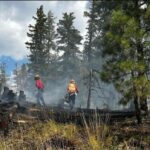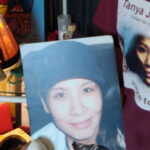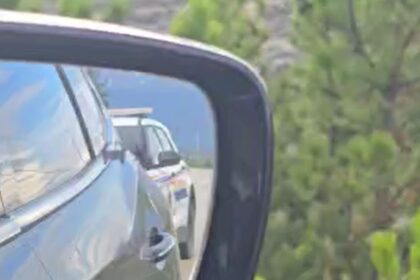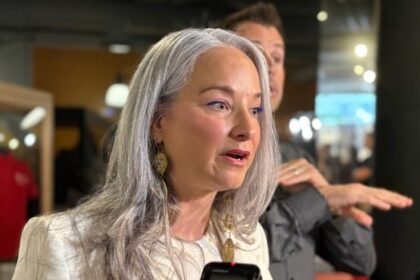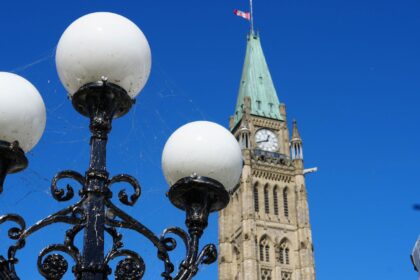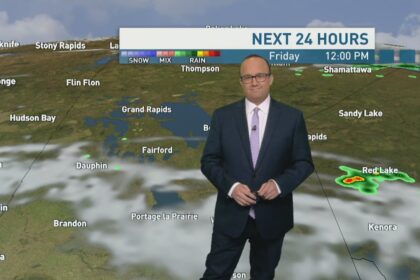Char George wasn’t planning to become a language teacher. She wasn’t even planning to learn Squamish. “I had other priorities at the time,” said George, who is also known as S7tsáliya “I had kind of dipped my toes into archaeology and I had been working in the health department for one of my nations and I was pretty happy with the way things were going.” But a friend of hers, Dustin Rivers, whose traditional name is Khelsilem, was starting a language class at Simon Fraser University and kept hounding her to sign up. She told her great-grandmother, Rosemary Thomas, that she wasn’t into it. “She gave me heck,” said George. “She was like, ‘how dare you.’” George said her grandmother lived through the loss of her language and watched generations of her family have their language taken away by colonial systems. George’s hesitation struck her grandmother as part of a much deeper historical wound. “She was like, ‘you need to learn your language, you need to learn it,’” George told APTN News at the Waves 2025, a conference organized by the Office of the Commissioner of Indigenous Languages. That moment became a turning point. She signed up for the course.. So did Swú7wu Billy, who never expected to become fluent in a language that seemed out of reach. Like many in his community, he said he grew up hearing just fragments. “It seemed like this mythical thing,” he said. “It was such a stretch to think that I’d ever be able to speak it. I really wanted to but there was just no place to get it. “My late mother did the best she could. She wasn’t a language speaker. She taught me as much culture as she could.” He said the words he did know came in small, isolated moments. “Growing up in the community… belly button, méxweya, or head lice -méchen —those were the words we heard,” he said. Then one day in 2016, Billy got a message on Facebook from Rivers, about the new Squamish immersion program in partnership with Simon Fraser University. “He said, ‘Hey, we’ve got this language program going. You want to join it?’” Billy had just become a new father. He and his wife had recently moved to Vancouver and he was trying to make ends meet. “We had a couple of pennies to rub together,” he said. “I didn’t want to go back to school. I didn’t do very good at school in the first place. It was a lot of paperwork. I didn’t want to go.” But his wife pushed him to follow through. “She kind of kicked me in the butt,” he said. “She said, ‘You’ve always wanted this.’ And she helped me go. Same as my daughter. They both helped me join the program.” It didn’t take long for everything to change. “There was definitely a moment, a couple months in, where I was like, ‘Oh my gosh, I’m speaking Squamish.’ I never thought that’d happen.” Not only did George and Billy learn to speak, but they never stopped. And they also took over the program, becoming teachers. “Nine years later, I’m still speaking my language, using my language and I wouldn’t be doing the things I’m doing if it wasn’t for my late great grandmother,” George said. Back from the Brink of extinction George and Billy were in Ottawa to share their story at the Waves 2025 conference, hosted by the Office of the Commissioner of Indigenous Languages George and Billy were in Ottawa to share their story at the Waves 2025 conference, hosted by the Office of the Commissioner of Indigenous Languages which brought together more than 1,000 people interested in preserving and revitalizing Indigenous languages. Their story, they said, is about saving the language at a critical moment. In 2016, the Squamish Nation faced a crisis. Only seven people had Squamish as a first language. There were fewer than 20 people who had learned Squamish as a second language, and spoke it well enough to hold a conversation. That’s in a community of 4,300 people, on and off reserve. That year, as George and Billy entered their first adult immersion program, they realized how fragile the ties to the language could be. Five of the seven language speakers passed into the spirit world before the first class graduated. As for the program, it was unlike anything they’d ever experienced. “It basically took all the norms of what you think of a university program to be, threw them out the window,” said Billy. “We spent about 40 hours a week together in class. I think we did like 900 hours of immersion or something crazy like that in those eight months.” By the end of the year, George and Billy became teaching assistants. A year later, they took over the program. In the nine years since, they have graduated 70 fluent language speakers. The hope is that those 70 will teach others, including their children and one day there will be first language speakers again. Live the language S7atsaliya, Char George says they moved the language program out of the classroom and into real life. In the program’s third year, George and Billy moved it out of the classroom and into a house, known as the Yellow House. “We’ve been working in an actual house, teaching our students in a home,” said George. “That’s where we can establish things like cleaning in the language, cooking in the language, interacting in a home in the language so that our students can go home and have no excuse to not use language there.” After the first month in the program, George and Billy banned the use of English. And they don’t let the learners use dictionaries. Learning the language without relying on English translation, they explained, means learning to think like their ancestors—positioned in relation to place, people, and emotion in an entirely different way. “For the first couple of weeks, it’s pretty quiet,” Billy said. “But it’s surprising. Every year, we’re surprised at how fast people will start even like joking in the language. It makes them have to survive.” Each year, the program continues to grow—not just in numbers, but in fluency. “When we moved into an immersion house, the point of fluency that students reached by the end, every year, it’s getting more and more fluent. It’s taking our students half the time to get to that same spot we did after a year,” said Billy. That success is part of the program’s design. From day one, students are treated not just as learners, but as future teachers. “We’re very honest with them,” said Billy. “We say that you’re all going to be teachers of this language. “We need the language to spread and we need our students to become teachers.” That strategy is already working. “We have some of our past students… instructing with us,” Billy said. “There was a moment where two of them, they were setting everything up and I walked over, and said ‘hey, I’m gonna help you’ and they said, ‘hey, what are you doing with our students?’ Like they’re getting territorial over these students… saying, ‘You can go sit down now. We got this.’” There’s even some friendly FOMO (fear of missing out) driving enrollment. “This year was the most applicants we’ve ever had for this program,” George said. “We’re starting to become cool.” Read more: Committee on First Nations languages says large disparity in language funding in Quebec Revitalization the focus of Indigenous languages summit in Ottawa That sense of excitement is showing up everywhere—from community events to family homes. “My husband was, you know, hearing all through COVID… me working on the laptop… he’s in the program this year,” said George. “He’s like, ‘yeah, I want to talk to my wife… when we have kids, I want to help raise our kids in the language.’” Some applicants say their children are coming home speaking Squamish and they want to catch up. Others are joining simply to be part of something that once felt out of reach. “I remember when we first started, we’d go to a ceremony… I was looking around, I’m like, there’s only one person here that understands what I’m saying,’” Billy said. “Nowadays… there’s like 15 people here that can understand now, which is awesome.” Thinking like the ancestors Billy said describes the connection between land and language. Learning an Indigenous language forces learners to think differently, not just speak differently, said George. The structure of Squamish often flips the expected order of English. Future tense, for example, doesn’t say “I will go over there’ —it comes out as ‘Go over there, I will.’ “Sometimes it does sound like Yoda,” George said, laughing. “Like, ‘Language I speak. Do I?’” “I think one way that learning Squamish—and learning any Indigenous language—works is that you start to be able to see the world through your ancestors’ eyes and the way they thought of the world,” she said. Billy said he was struck by the difference when he learned how to provide directions in Squamish. “You don’t say left or right—you say ‘toward the water,’ ‘toward the mountains,’ ‘toward the head of the river.’ That’s how you know where you are—by your relationship to water, to land,” he said. “If I’m talking to Char about where something is, it’s harder to do it if I don’t know where I am in relation to the land.” For George, her great-grandmother didn’t live to see the full impact of all she accomplished. But she felt it. “After she convinced me to take the program in the summer of 2016, she passed in the spring of 2017,” George said. In those final months, George would visit her. Sometimes her great-grandmother wouldn’t respond when spoken to in English. But something shifted when George spoke in Squamish. “When I would speak English to her, she wouldn’t respond. Like, she wasn’t very lucid,” she said. “And when I would speak Squamish to her, she would look. And she would nod.” George doesn’t describe it as a full conversation. But it was something. “I couldn’t talk to her. But on a spiritual level, I know that she knew, and she’s here guiding all the time,” she said. “I know that she’s around all the time. I feel her all the time. I feel her here.” Continue Reading
Speaking like our ancestors: The immersion program bringing back the Squamish language
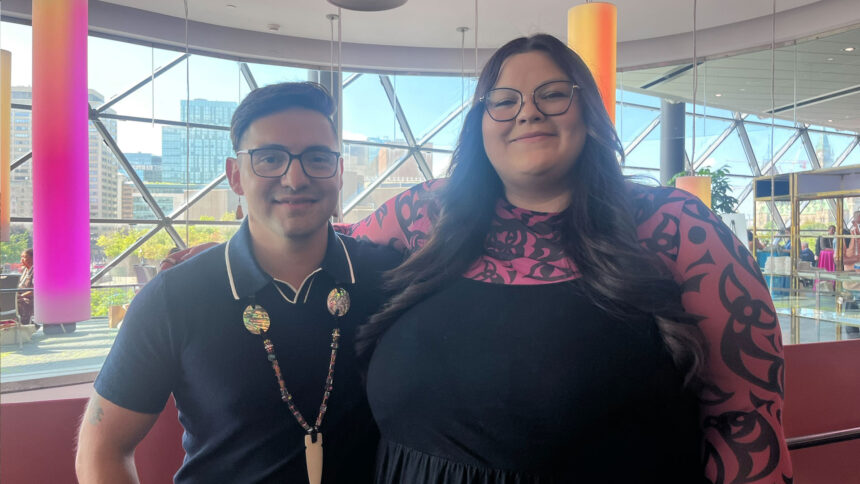
Leave a Comment


